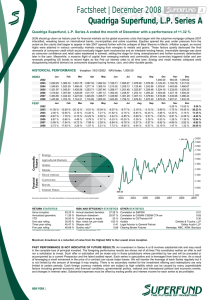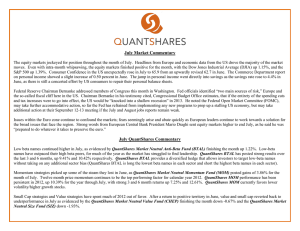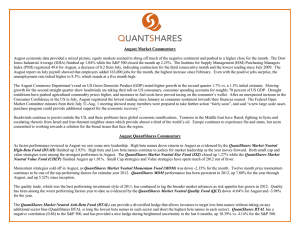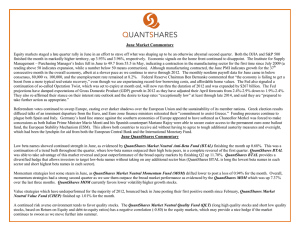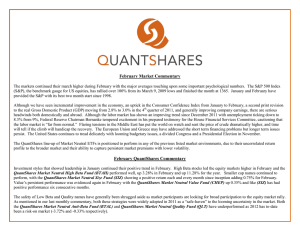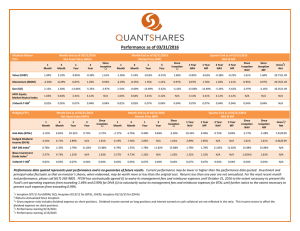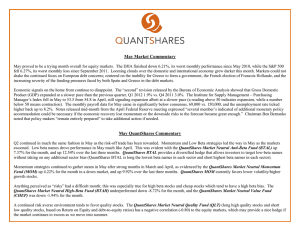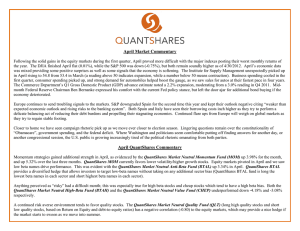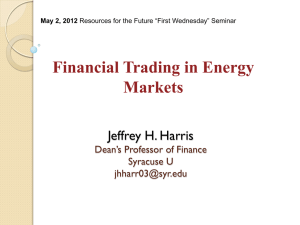Hedge with BTAL
advertisement
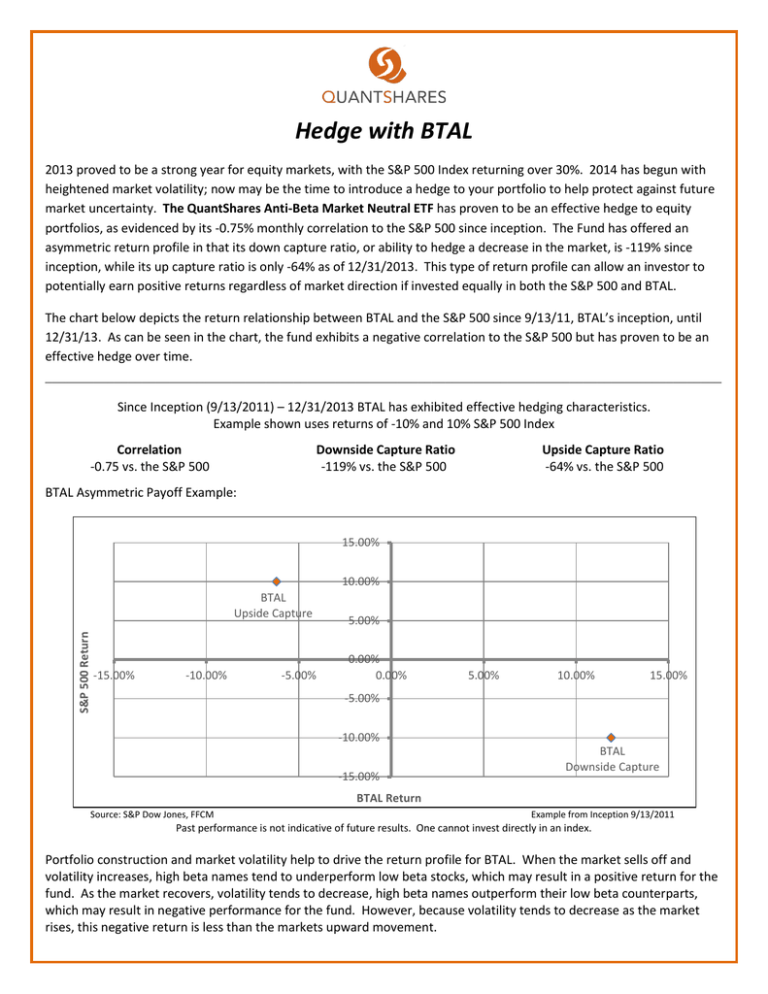
Hedge with BTAL 2013 proved to be a strong year for equity markets, with the S&P 500 Index returning over 30%. 2014 has begun with heightened market volatility; now may be the time to introduce a hedge to your portfolio to help protect against future market uncertainty. The QuantShares Anti-Beta Market Neutral ETF has proven to be an effective hedge to equity portfolios, as evidenced by its -0.75% monthly correlation to the S&P 500 since inception. The Fund has offered an asymmetric return profile in that its down capture ratio, or ability to hedge a decrease in the market, is -119% since inception, while its up capture ratio is only -64% as of 12/31/2013. This type of return profile can allow an investor to potentially earn positive returns regardless of market direction if invested equally in both the S&P 500 and BTAL. The chart below depicts the return relationship between BTAL and the S&P 500 since 9/13/11, BTAL’s inception, until 12/31/13. As can be seen in the chart, the fund exhibits a negative correlation to the S&P 500 but has proven to be an effective hedge over time. __________________________________________________________________________________________________ Since Inception (9/13/2011) – 12/31/2013 BTAL has exhibited effective hedging characteristics. Example shown uses returns of -10% and 10% S&P 500 Index Correlation -0.75 vs. the S&P 500 Downside Capture Ratio -119% vs. the S&P 500 Upside Capture Ratio -64% vs. the S&P 500 BTAL Asymmetric Payoff Example: 15.00% 10.00% S&P 500 Return BTAL Upside Capture -15.00% -10.00% -5.00% 5.00% 0.00% 0.00% 5.00% 10.00% 15.00% -5.00% -10.00% -15.00% BTAL Downside Capture BTAL Return Source: S&P Dow Jones, FFCM Example from Inception 9/13/2011 Past performance is not indicative of future results. One cannot invest directly in an index. Portfolio construction and market volatility help to drive the return profile for BTAL. When the market sells off and volatility increases, high beta names tend to underperform low beta stocks, which may result in a positive return for the fund. As the market recovers, volatility tends to decrease, high beta names outperform their low beta counterparts, which may result in negative performance for the fund. However, because volatility tends to decrease as the market rises, this negative return is less than the markets upward movement. S&P 500 and QuantShares Anti-Beta BTAL Fund Hypothetical Performance Since Inception $180.00 $160.00 $140.00 $120.00 $100.00 $80.00 $60.00 $40.00 $20.00 $- BTAL_TR S&P 500 Daily Returns Past Performance is not indicative of future results. One cannot invest in an index Inception 9/13/2011 The chart below shows the relationship of the returns between the S&P 500 and BTAL Since Inception. Month End 12/31/2013 Quarter End 12/31/2013 BTAL NAV BTAL MP S&P 500 BTAL NAV BTAL MP S&P 500 1 Month -1.18% -1.28% 2.52% -1.18% -1.28% 2.52% 3 Month -1.84% -1.99% 10.51% -1.84% -1.99% 10.51% 1 Year -11.47% -11.63% 32.38% -11.47% -11.63% 32.38% 2 Year -1.78% -2.67% 14.15% -1.78% -2.67% 14.15% Since Inception -10.10% -10.10% 25.02% -10.10% -10.10% 25.02% Inception 9/13/2011 NAV = Net Asset Value MP = Market Price Performance data quoted represent past performance and is no guarantee of future results. Current performance may be lower or higher than the performance data quoted. Investment and principal value fluctuate so that an investor’s shares, when redeemed, may be worth more or less than the original cost. Returns less than one year are not annualized. Gross Expense Ratio for BTAL is 4.74%. FFCM has contractually agreed to waive its management fees and reimburse expenses until October 31, 2014 to the extent necessary to prevent the Fund’s net operating expenses from exceeding 0.99%. For more information on how to use BTAL to hedge equity exposure or on any other QuantShares ETFs, please call Kevin Collins at 617-292-9801 or visit www.quant-shares.com/BTAL. Before investing you should carefully consider the Fund’s investment objectives, risks, charges, and expenses. This and other information is in the Fund’s prospectus which can be obtained at www.quantshares.com. Please read the prospectus carefully before you invest. Foreside Fund Services, LLC, Distributor Shares are not individually redeemable and can be redeemed only in Creation Units. The market price of shares can be at, below or above the NAV. Market Price returns are based upon the midpoint of the bid/ask spread at 4:00PM Eastern time (when NAV is normally determined), and do not represent the returns you would receive if you traded shares at other times. Fund returns assume that dividends and capital gains distributions have been reinvested in the Fund at NAV. Some performance results reflect expense subsidies and waivers in effect during certain periods. Absent these waivers, results would have been less favorable. Risks: There is no guarantee that the funds will reach their objective. An investment in the Funds is subject to risk including the possible loss of principal amount invested. See prospectus for specific risks regarding BTAL. There is a risk that during a “bull” market, when most equity securities and long only ETFs are increasing in value, the Funds’ short positions will likely cause the Fund to underperform the overall U.S. equity market and such ETFs. The Funds may not be suitable for all investors. Short selling could cause unlimited losses, derivatives could result in losses beyond the amount invested, and the value of an investment in the Fund may fall sharply. S&P 500 is an index of 500 large cap common stocks actively traded on the NYSE and NASDAQ. One cannot invest directly in an index. Sharpe Ratio: The measure of the risk-adjusted return of an investment. Standard Deviation: indicates the volatility of a fund’s total return. In general, the higher the standard deviation, the greater the volatility of return. Correlation: A statistical measure of how two securities move in relation to each other. Ranges between -1 and +1, positive correlation implies that as one security moves, either up or down, the other security will move in the same direction. Negative correlation implies that if one security moves in either direction, up or down, the other security will move in the opposite direction. Upside Capture Ratio: A statistical measure of an investment manager’s overall performance in up markets. The up-capture ratio is used to evaluate how well or poorly an investment manager performed relative to an index during periods when that index has risen. Downside Capture Ratio: The down-capture ratio is used to evaluate how well or poorly an investment manager performed relative to an index during periods when that index has dropped. There is a risk that the present and future volatility of a security, relative to the market index, will not be the same as it has historically been and thus the Fund will not be invested in low beta securities. In addition, the Fund may be more volatile than the universe since it will have short exposure to the most volatile stocks in the universe and long exposure to the least volatile stocks in the universe. Short selling could cause unlimited losses, derivatives could result in losses beyond the amount invested, and the value of an investment in the Fund may fall sharply. The owners of Shares may purchase or redeem Shares from the Fund in Creation Units only, and (ii) the purchase and sale price of individual Shares trading on an Exchange may be below, at, or above the most recently calculated NAV for such shares.
